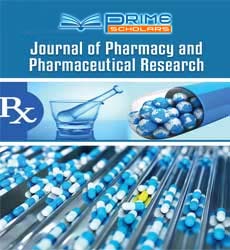Commentary Article - (2022) Volume 6, Issue 1
A Short Commentary on Pharmacognosy
Vishu Lucy*
Department of Pharmacy, Visheswar University of American Samoa, American Samoa
*Correspondence:
Vishu Lucy, Department of Pharmacy, Visheswar University of American Samoa,
American Samoa,
Email:
Received: 26-Jan-2022, Manuscript No. IPIPR-22-12814;
Editor assigned: 28-Jan-2022, Pre QC No. IPIPR -22-12814 (QC);
Reviewed: 11-Feb-2022, QC No. IPIPR -22-12814;
Revised: 16-Feb-2022, Manuscript No. IPIPR -22-12814 (R);
Published:
23-Feb-2022, DOI: 10.21767/IPIPR.6.1.04
Introduction
These auxiliary metabolites and colors can have helpful activities
in people and which can be refined to deliver drugs-models
are inulin from the underlying foundations of dahlias, quinine
from the cinchona, THC and CBD from the blossoms of pot,
morphine and codeine from the poppy, and digoxin from the
foxglove. Plants orchestrate an assortment of phytochemicals,
yet most are subordinates: Alkaloids are a class of synthetic
mixtures containing a nitrogen ring. Alkaloids are created by
an enormous assortment of living beings, including microorganisms, organisms, plants, and creatures, and are essential
for the gathering of normal items. Numerous alkaloids can
be decontaminated from unrefined concentrates by corrosive
base extraction. Numerous alkaloids are harmful to different
organic entities. Polyphenols are intensifies that contain phenol
rings. The anthocyanins that give grapes their purple tone,
the is flavones, the phytoestrogens from soy and the tannins
that give tea its astringency are phenolics. Glycosides are particles
in which a sugar is bound to a non-starch moiety, normally
a little natural atom. Glycosides assume various significant
parts in living beings. Many plants store synthetic compounds
as idle glycosides. These can be initiated by compound hydrolysis, which causes the sugar part to be severed, making the
substance accessible for use. Terpenes are an enormous and
different class of natural mixtures, delivered by an assortment
of plants, especially conifers, which are regularly solid smelling
and in this manner might have a defensive capacity. They are
the significant parts of gums, and of turpentine delivered from
gums. At the point when terpenes are adjusted synthetically,
for example, by oxidation or reworking of the carbon skeleton,
the subsequent mixtures are for the most part alluded to as
terpenoids. Terrenes and terpenoids are the essential constituents of the medicinal ointments of many sorts of plants and
blossoms. Rejuvenating ointments are utilized generally as normal
flavor added substances for food, as scents in perfumery,
and in conventional and elective drugs like fragrance based
treatment. Manufactured varieties and subordinates of regular terpenes and terpenoids likewise extraordinarily grow the
assortment of smells utilized in perfumery and flavors utilized
in food added substances. The aroma of rose and lavender is
expected to monoterpenes. The carotenoids produce shades
of red, yellow and orange in pumpkin, corn and tomatoes.
Description
Pharmacognosy is the investigation of plants and other regular
substances as potential wellsprings of medications. The American Society of Pharmacognosy characterizes pharmacognosy as
“the investigation of the physical, synthetic, biochemical, and
organic properties of medications, drug substances, or expected
medications or medication substances of regular beginning
as well as the quest for new medications from normal sources.
Organic foundation: All plants produce synthetic mixtures as
a feature of their ordinary metabolic exercises. These phytochemicals are isolated into essential metabolites, for example,
sugars and fats, which are found in all plants; and auxiliary metabolites-intensifies which are found in a more modest scope
of plants, serving more explicit capacities. For instance, a few
optional metabolites are poisons utilized by plants to hinder
predation and others are pheromones used to draw in bugs for
fertilization.
Conclusion
Regular items science: A commonplace convention to seclude
an unadulterated synthetic specialist from normal beginning is
bioassay-directed fractionation, importance bit by bit partition
of removed parts in light of contrasts in their physicochemical properties, and surveying the organic movement, trailed by
next round of detachment and examining. Regularly, such work
is started after a given rough medication definition (ordinarily
ready by dissolvable extraction of the normal material) is considered “dynamic” in a specific in vitro examine. If the ultimate
objective of the current work is to recognize which one of the
scores or many mixtures are liable for the seen in vitro movement, the way to that end is genuinely clear.
Citation: V Lucy (2022) A Short Commentary on Pharmacognosy. J Pharm Pharm Res Vol.6 No.1:04
Copyright: © V lucy. This is an open-access article distributed under the terms of the Creative Commons Attribution License, which permits unrestricted use, distribution, and reproduction in any medium, provided the original author and source are
credited

